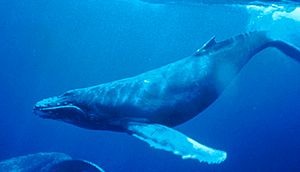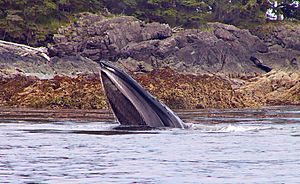Rorqual facts for kids
Quick facts for kids Rorquals |
|
|---|---|
 |
|
| Humpback Whale, Megaptera novaeangliae | |
| Scientific classification | |
| Kingdom: | |
| Phylum: | |
| Class: | |
| Order: | |
| Suborder: | |
| Family: |
Balaenopteridae
Gray, 1864
|
| Genera | |
Rorquals are the biggest group of baleen whales. There are nine different kinds, split into two main groups. This family includes the largest animal ever known, the Blue Whale. This giant can weigh as much as 150 tonnes! Another rorqual can reach 70 tonnes. Even the smallest rorqual, the Northern Minke Whale, weighs about 9 tonnes.
Contents
What Makes Rorquals Special?
All rorquals have special folds of skin under their mouths. These folds run from their chin all the way back to their belly button. (Except for the sei whale and common minke whale, which have shorter folds.)
How Do These Folds Help Them Eat?
These amazing folds let their mouths open super wide when they eat. This helps them scoop up huge amounts of food and water in one big gulp! These "pleated throat grooves" are what make rorquals different from other whales.
Rorquals have a sleek, streamlined body shape. They are much thinner than their relatives, the right whales. Most rorquals also have long, narrow flippers. They have a fin on their back, located about two-thirds of the way down their body.
What Do Rorquals Eat?
Rorquals eat by gulping in water. Then, they push the water out through special plates called baleen using their tongue. The baleen acts like a giant filter, trapping tiny sea creatures. They mostly eat small crustaceans like krill. But they also enjoy different kinds of fish, such as herrings and sardines.
Where Do Rorquals Live?
Rorquals live all over the world! You can find blue, fin, humpback, and sei whales in all the major oceans. The common (northern) and Antarctic (southern) minke whales live in the oceans of their own half of the world.
Which Rorquals Stay Near Shore?
Most rorquals live far out in the open ocean. But there are a few exceptions. Bryde's whale and Eden's whale usually stay close to the shore all year. The humpback whale also swims close to shore when it travels for migration.
The biggest rorquals, like the blue whale, and the smallest, like the Antarctic minke whale, live in the coldest waters far south. Fin whales usually don't go quite as close to the ice. Sei whales tend to stay even further north.
How Do Rorquals Migrate?
Most rorquals travel to warm, tropical waters in the winter to have their babies. Then, they swim back to the cold polar areas for the short polar summer. These cold waters are full of tasty plankton and krill, which is perfect for feeding!
How Rorquals Find Food

Rorquals have a special way of eating called "lunge-feeding." They often do this when they find a "bait ball" – a tight group of small fish.
What is Lunge Feeding?
Lunge feeding is an amazing way to eat! The whale swims very fast and then opens its mouth super wide. This creates a lot of water pressure. This pressure helps their mouth expand and lets them scoop up a huge amount of water and fish.
Rorquals have special body parts that help them do this.
- Their lower jaws can move separately.
- Their throat pleats can stretch to a massive size.
- They have a unique sensory organ. This organ is a group of special nerves that helps their brain control the gulping action.
- Their large nerves are flexible. They can stretch out when the mouth opens and then snap back when it closes.
Rorquals can open their mouths so wide that they can take in more water than their own body size! When they open their mouths, these nerves unfold. Then, they snap back into place when the mouth closes. Scientists say that lunge feeding in rorquals is the biggest "biomechanical" event on Earth. This means it's one of the most powerful and impressive movements in the animal kingdom!
Images for kids
See also
 In Spanish: Balenoptéridos para niños
In Spanish: Balenoptéridos para niños


